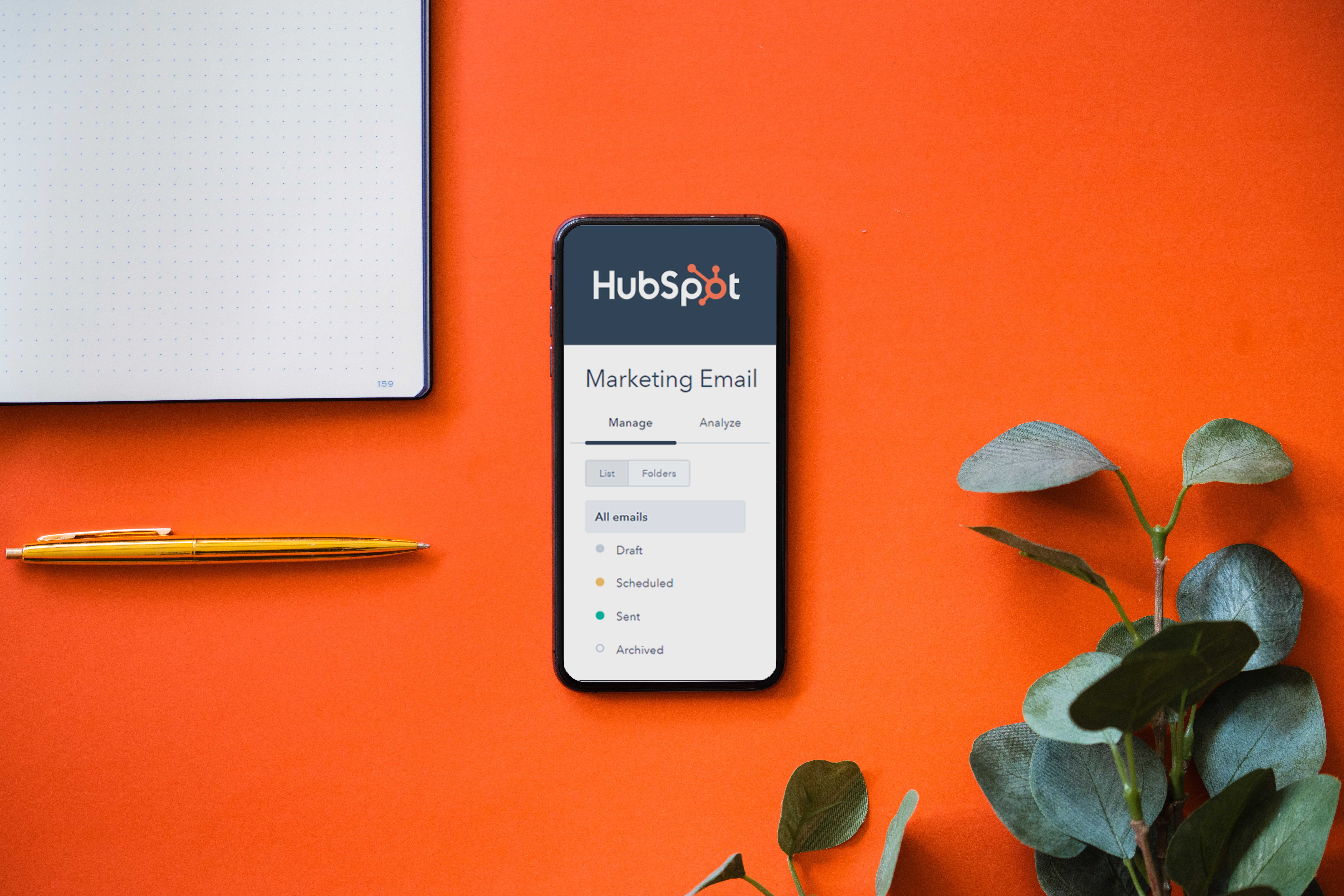
Did you know that 78% of Marketers have seen an increase in email engagement in the past 12 months? Despite being seen as a more "traditional" medium, Email Marketing is one of the few channels that continuously generates a real connection with your audience, so your business should not overlook it; Email Marketing should be a must in your Content Marketing Strategy.
In this post, we will analyze the advantages that email can offer your business, and the first steps for getting started with Email Marketing in HubSpot.
Advantages of Email Marketing in HubSpot
There are many platforms you can use for your Email Marketing campaigns, such as Mailchimp, Pardot, Marketo, and ActiveCampaign. However, we recommend HubSpot, as it is the #1 Marketing Automation platform on the market, offering these key advantages:
- With HubSpot,integrate Email Marketingwith all of your content and pages, automated workflows, sales and service funnels. It's an all-in-one platform that provides a truly seamless experience.
- Design professional emails without having knowledge of web design. You will be able to choose from hundreds of templates and easily customize them in the Drag and Drop editor.
- Personalize emails with Smart Content to improve CTR and Open Rate. HubSpot lets you segment by Buyer Persona, lifecycle stage, products of interest, level of engagement, etc.
- HubSpot includes email metrics so you know about interactions from opens vs. clicks, device type, downloads, and more.
- Perform A/B testing to find out what content and design works best and optimize future email sends.
Essentials for Email Marketing Campaigns
1.Establish your KPIs
Always keep in mind some basic KPIs that will determine whether your campaign is working properly:
- Open rate: An average open rate will fall between 15% and 25%. There are very few campaigns that achieve an open rate above 40%, but the more personalized your emails are, the more possibilities you have to improve that percentage.
- Click-through-rate: The average Marketing email has a CTR of around 2.5%. To improve this, you can follow best practices for A/B testing on CTA buttons as well as content offers.
- Spam: Minimize the risk of being marked as spam by crafting a truthful subject line, using a reputable email address, and following a consistent sending schedule (without oversending). Consider excluding contacts who are disengaged.
- Opt out: The best way to prevent opt-outs is to offer highly-relevant, personalized content for your audience.
2. Segment your audience
 Having a deep knowledge of your audience is essential to any Marketing strategy, and that includes email. An email will only be impactful if it is sent to the right person, at the right time, with the right information. Thus, a good starting point for any Marketing strategy is to define your Buyer Personas.
Having a deep knowledge of your audience is essential to any Marketing strategy, and that includes email. An email will only be impactful if it is sent to the right person, at the right time, with the right information. Thus, a good starting point for any Marketing strategy is to define your Buyer Personas.
In your email campaigns, you can segment based on these Buyer Personas, along with other demographics and database properties including location, product, buying role, etc. You should also factor in the stage your contacts are at in the Buyer's Journey, as this will influence whether your content should be more educational (people earlier in the buying cycle) vs. commercial (people in advanced stages of the buying cycle).
Naturally, not every single lead will be interested in every email you send out, so segmentation is a fundamental part of Email Marketing. In fact, 75% of recipients are more likely to open an email if it comes from a segmented campaign. The benefits of segmentation are twofold: your customers receive content that really interests them and your conversion metrics increase!
3.Design your email campaign
With your KPIs and audience in mind, you can now start to design your actual email campaign. This will revolve heavily around the goal of each email (educational vs. commercial), type of email (welcome email, newsletter, lead nurturing), content involved (videos, landing pages, CTA buttons), and design elements.
For crafting your email send outs, always follow these known best practices:
- Subject line:You have a limited number of characters, so it's important to be brief, direct, and engaging all at once. Including personalization, such as the person's name could make your open rate jump from 10% to 14%.
- Content: You don't want to stuff the email with unnecessary information or visuals. 86% of people say that more than half the emails they receive are not useful; position yourself in the remaining 14% by staying focused on one core message or objective.
- Design: Adhere to your normal brand guidelines, since you want recipients to recognize your emails immediately. Make sure to keep the design as simple as possible, eliminating distracting elements and using visuals to guide the reader to CTA buttons.
- Footer: Your footer should include your company's contact information and social media links, as well as an unsubscribe link. Failure to offer an opt-out option could lead to more spam reports.
- Email volume: Every company will have a different reader base and rhythm, so when starting a new campaign, it's best to roll out slowly to not oversaturate or annoy readers. After analyzing the first results (opens, clicks, and conversions), you can optimize your email volume over time.
4. Conduct analysis and optimization
Once your campaign has been launched, the work isn't over; afterwards, it's time toanalyze the resultsandoptimize future send outs.
Reflect back on the KPIs you established at the very beginning and see how they align with the Open Rate and CTR you actually achieved. If your Open Rate was lower than expected, doA/B testingon different subject lines. As for the CTR, do A/B testing on CTA buttons as well as content offers.
Don't forget to generate a standardized Email Marketing report to follow the progress of your campaigns and help with decisions regarding future campaigns.
How to implement Email Marketing in HubSpot
Email Marketing is one of HubSpot's primary offerings in the Marketing Hub, and the tool is to easy to use that you'll be an expert in no time! In the sections below, you will discover how to create emails, edit templates, program automation, and access HubSpot's email metrics.
How to create and send emails in HubSpot
Let's go back to basics and learn how to create and send emails in HubSpot.
- In your HubSpot account, navigate to the top menu and click on: Marketing > Email
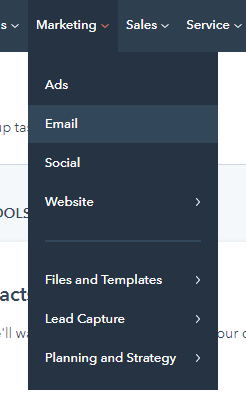
- In the upper right corner of the Email homepage, click the button "create email". A box will appear with 3 different email types: Normal (sent to a specific list or segment of contacts), Automated (automatically sent out according to the conditions of your workflows), and Blog/RRSS (sent when you publish new content on your blog or social platforms).
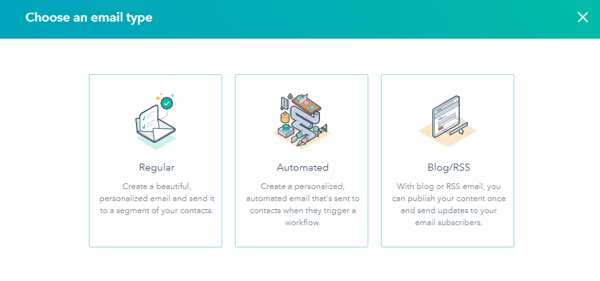
- Once you've chosen the type of email, it's time to select an email template. You can use default HubSpot templates or build your own template. With the Drag and Drop editor, it's easy to make changes to the body elements (headers, videos, tables), change colors and fonts, add Personalization Tokens, include CTA buttons, etc.
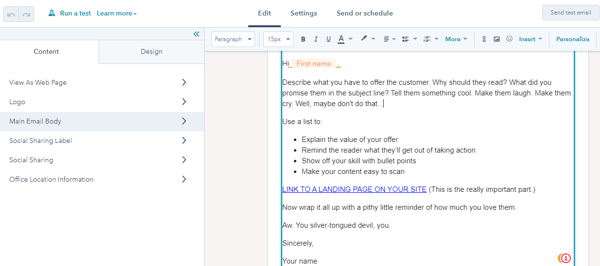
4. To send your finished email, advance to the tab that says "Send or Schedule". Select the lists and/or individual contacts that you want your email to reach (here, you can also add exclusion or suppression lists). Then, you can either send the email out at that very moment or program it for another time/date.
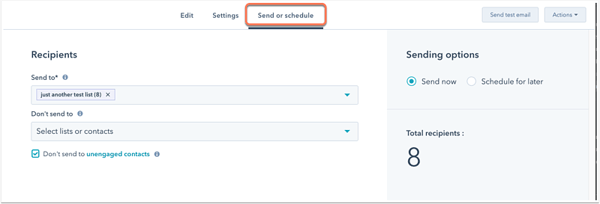
How to program automated emails in HubSpot
In HubSpot, to be able to send an email in an automated way, the first thing you should do is create an Automated type email. When it is created and published, you can start working with workflows.
- In the HubSpot top menu, navigate to Automation > Workflows. There you will have the option to choose an existing workflow or create a new one.
- Once in the workflow editor, click on the + icon to add the action you want your workflow to perform.

- In the right-hand panel, click the Send Email option. Here you can choose the automated email you previously created in the Email section, or create a new automated email.
- Click on "create new email" and fill out the details of your email.
- Once you have finished composing your email, click on "save email" in the lower right corner. Once this is done, you will be able to use that email in any workflow!
Analyze and Health Tabs in HubSpot
Finally, we cannot talk about email marketing in HubSpot without mentioning the Analyze and Health tabs. To access these features, go back to the Marketing > Email section and you will find them at the top.
The Analyze tab allows you to analyze aspects such as user interaction (number of emails sent, CTR, Open Rate), email deliveries made (percentage of emails delivered, unsubscribes, spam reports), and the performance of emails (device type, time spent reading) All of this customized by date range.

The Health tab allows you to observe general trends about your emails. The HubSpot software uses AI and machine learning to categorize your emails as "on track", "work to be done", or "action needed", depending on email performance and comparison. You'll see which emails have problems and receive tips from HubSpot on how to optimize them.

It's easy to get started with HubSpot Email Marketing, jumping right in to everything from audience segmentation, automated campaigns, and email metrics. You'll soon see it become a vital part of your Inbound Marketing strategy. If you're still curious about HubSpot or Email Marketing, get in touch with the experts at mbudo - we will resolve any of your doubts and help make your email strategy the best it can be.

Alexandra Martín
Alexandra is a true Marketing enthusiast. Her aspirations inspired her to leave her native home in the Canary Islands and move to Madrid. She enjoys all the great cultural and professional offerings that this city holds. Alexandra also loves the sea, her dogs, and music.
It may interest you
LATEST
BLOG POSTS
SUBSCRIBE TO MBUDO BLOG
And get your inbound news directly in
your inbox, once a month.

